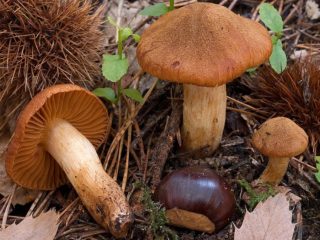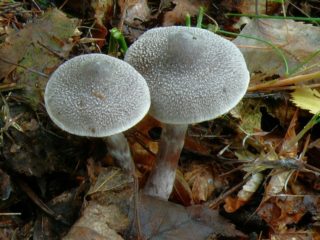Content
Spring cobweb is an inedible representative of the Cobweb family. Grows among broad-leaved and coniferous trees, in deciduous substrate, in moss or tall grass. This species is not used in cooking, therefore, in order to avoid food poisoning, you need to study its external characteristics before a quiet hunt.
What does the spring web spider look like?
Spring webwort is not eaten, so it is important to highlight its differences from its edible counterparts. This will prevent you from putting a health-hazardous item in your basket.
Description of the cap
The hat, up to 6 cm in diameter, has the shape of a bell; as it grows, it gradually straightens and becomes flat-spread, leaving a small hill in the center. The edges are smooth or wavy; in dry weather they become brittle and brittle. The dry surface is smooth, silky, covered with brown or dark brown skin with a purple tint.
The lower layer is formed by thin, dirty-gray plates, which are covered with a dense blanket at a young age. As it grows, the protection breaks through and descends in the form of a skirt onto the leg. The gray-brown pulp is dense, without a pronounced taste or smell. Reproduction occurs by elongated spores, which are collected in reddish-brown powder.
Description of the leg
The leg, up to 10 cm high, is cylindrical in shape and covered with gray-brown skin, with pronounced redness closer to the ground. The pulp is fibrous, tasteless and odorless. The color depends on the place and time of growth.
Where and how does it grow
Spring cobweb prefers to grow on rotten trunks of deciduous and coniferous trees, stumps and dead wood. It can be found in clearings, along roads, in open glades, in moss and grass.
Is the mushroom edible or not?
Due to the lack of taste and aroma, this forest dweller is not eaten. But, despite the fact that toxicity has not been identified, experienced mushroom pickers recommend passing by unknown specimens.
Doubles and their differences
The spring cobweb, like any inhabitant of the forest, has false brothers. These include:
- Bright red – an inedible species, grows from May to July. Grows in small families in damp places, coniferous and deciduous forests. The pulp is dense, with a characteristic floral aroma.The species can be recognized by its small conical brown-brown cap and thin, curved stem. The lower layer is formed by wide jagged plates of light brown color.
- Triumphal – a rare, edible species listed in the Red Book. The cap reaches a diameter of 12 cm and has a hemispherical or spherical shape. The surface is covered with shiny, slimy, bright orange peel. As it grows, it darkens and acquires a brown-red color. The pulp is dense, fleshy, without taste or aroma.
- Saffron is an inedible forest dweller that grows among coniferous trees, near ponds, and along roads. Found from July until the first frost. The cap is up to 7 cm in size, covered with fibrous, red-brown skin. The pulp is dense, has no smell or taste.
Conclusion
Spring cobweb is an inedible representative of the forest kingdom. Grows in mixed forests from April to November. Since the species has edible relatives, you need to be able to distinguish it by its external characteristics. During mushroom hunting, it is necessary to remember that inedible, little-known specimens can cause irreparable harm to health.














